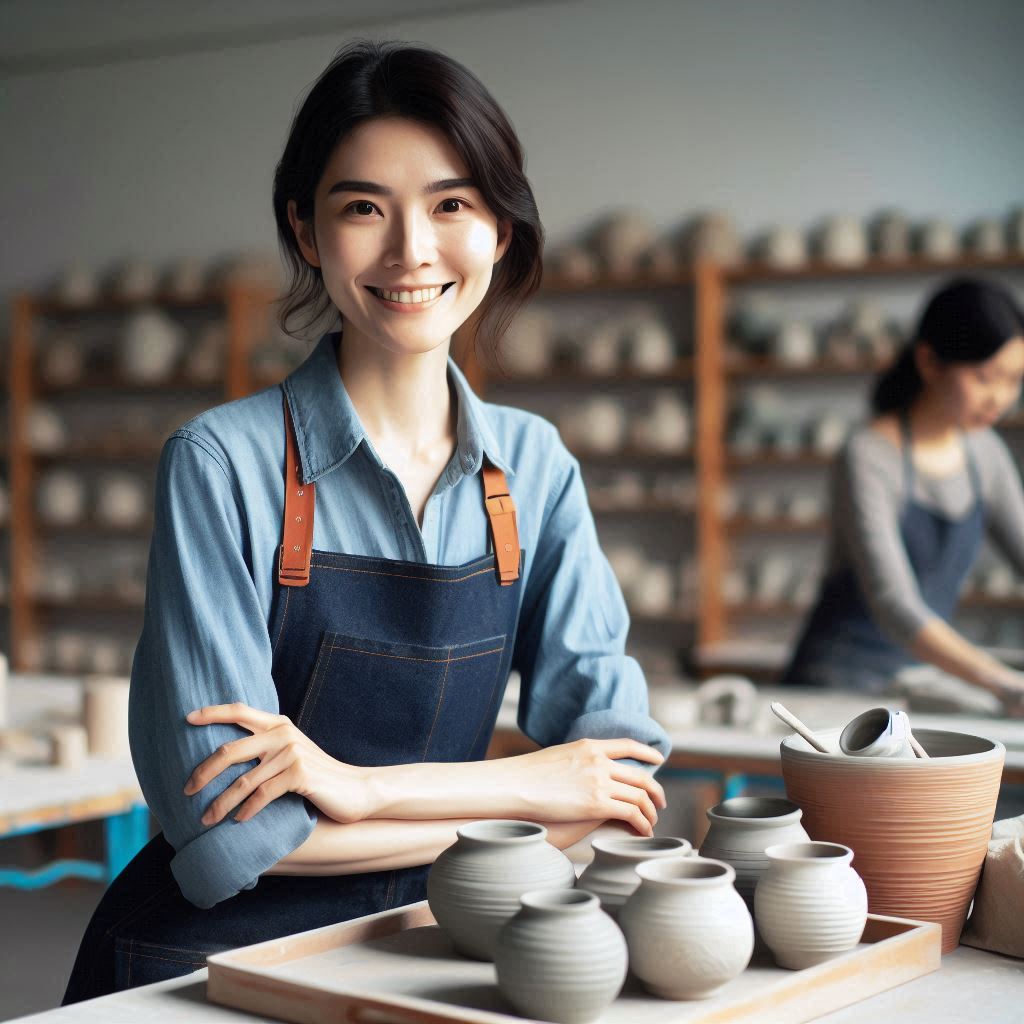Introduction
Unlocking the secret to stunning ceramic art begins with finding true inspiration.
Every artist needs a spark to ignite creativity. Without it, your pieces may lack originality and depth.
Inspiration fuels the creation of unique and meaningful ceramics.
Consider these sources of inspiration:
- Nature: Observe textures, colors, and patterns in natural landscapes.
- Culture: Explore traditional motifs and techniques from various cultures.
- Daily Life: Capture the essence of everyday moments and objects.
- Art History: Study past ceramic masters and their innovative styles.
Finding inspiration is crucial for crafting art that resonates.
It guides your creative process and influences your choice of materials and techniques.
By tapping into diverse sources, you can bring fresh perspectives and originality to your work.
Embrace inspiration as your artistic ally to produce ceramic pieces that are both unique and deeply personal.
Look to Nature for Inspiration
Natural elements such as plants, animals, and landscapes can serve as powerful sources of inspiration for ceramic design.
These elements offer a rich tapestry of colors, shapes, and textures that can be translated into stunning artworks.
How nature influences ceramic designs
Artists often draw inspiration from the intricate patterns found in plants, such as the delicate veins of a leaf or the vibrant hues of a flower.
Animal motifs, like feathers, scales, or fur, can add a sense of whimsy and vitality to ceramic pieces.
Landscapes, from lush forests to sweeping seascapes, can evoke a sense of tranquility and harmony in ceramic art.
Examples of nature-inspired ceramic art
Japanese ceramic artist Makoto Kagoshima creates charming pieces featuring whimsical floral and animal motifs.
American artist Eva Hild’s sculptural ceramics are inspired by the organic forms and textures of the natural world.
British potter Edmund de Waal often incorporates elements of the landscape, such as the patterns of rocks or the movement of water, into his minimalist designs.
Tips for finding inspiration in nature
- Take time to observe the world around you and notice the details that catch your eye.
- Bring a sketchbook or camera on nature walks to capture images and ideas for future ceramic projects.
- Experiment with different ways of interpreting nature, whether through color, form, or texture, in your ceramic art.
By immersing yourself in the beauty and complexity of nature, you can unlock a wealth of creative possibilities for your ceramic designs.
Let the shapes, colors, and textures of the natural world guide and inspire your artistic vision.
Read: How to Get Your Ceramic Art into Galleries
Explore different Cultures and Traditions
One of the most impactful ways to find inspiration for your ceramic art is by exploring different cultures and their art forms.
Transform Your Career Today
Unlock a personalized career strategy that drives real results. Get tailored advice and a roadmap designed just for you.
Start NowHow different cultures’ art forms can influence ceramic art
- Examine the techniques and styles used in traditional pottery from various regions.
- Notice how patterns, colors, and shapes differ based on cultural influences.
- Try to incorporate elements of different cultural art into your own ceramic pieces.
Significance of cultural symbols and motifs in ceramic design
- Understand the meaning behind symbols used in different cultures.
- Learn about the stories and traditions associated with specific motifs.
- Consider how you can use these symbols to add depth and meaning to your work.
Researching and studying various cultural traditions to spark creativity
- Read books, watch documentaries, and visit museums to learn about different cultures.
- Take note of elements that resonate with you and incorporate them into your art.
- Experiment with combining elements from multiple cultures to create unique pieces.
Overall, by immersing yourself in the art and traditions of different cultures, you can broaden your artistic horizons and find new sources of inspiration for your ceramic art.
Read: Innovative Materials in Printmaking Today
Experiment with Different Techniques
Experimenting with different techniques can breathe new life into your ceramic art.
Trying new methods not only stimulates creativity but also opens doors to innovative ideas.
Here’s how you can get started:
Explore Various Techniques
- Hand-building: Shape clay by pinching, coiling, or slab construction. This method offers endless possibilities for unique forms.
- Wheel-throwing: Use a potter’s wheel to create symmetrical, smooth pieces. Experiment with speed and pressure for diverse results.
- Glazing: Apply different glaze techniques to discover unexpected textures and colors. Consider layering glazes for intricate effects.
- Sculpting: Carve or mold clay into detailed sculptures. Play with textures and forms to push the boundaries of your creativity.
Step Out of Your Comfort Zone
- Embrace Unfamiliar Materials: Use materials like porcelain or stoneware. Each type of clay has its own characteristics and challenges.
- Experiment with Non-Traditional Tools: Try using brushes, sponges, or even household items for applying textures and patterns.
- Incorporate Mixed Media: Combine ceramics with other materials like metal or glass. This fusion can lead to groundbreaking pieces.
Venturing into unfamiliar techniques helps break creative blocks and fosters growth.
It encourages you to see your work from a fresh perspective.
Attend Workshops and Classes
- Join Local Ceramics Workshops: Learn new techniques from experienced artists. Workshops offer hands-on practice and immediate feedback.
- Enroll in Specialized Classes: Find classes focusing on specific skills, such as advanced glazing or sculpting techniques.
These classes can deepen your expertise. - Network with Fellow Artists: Workshops and classes provide opportunities to connect with other ceramicists.
Sharing experiences can inspire and motivate you.
Stepping outside your comfort zone and engaging with new techniques revitalizes your art and keeps it exciting.
Embrace the journey of exploration and let it guide your creative process.
Read: Creating a Unique Style in Ceramic Art

Keep a Sketchbook for Ideas
A sketchbook is a powerful tool for ceramic artists.
It allows you to capture fleeting ideas and inspirations.
Keeping a sketchbook helps you track your creative evolution over time.
Importance of jotting down ideas and sketches for future reference
Ideas for ceramic art can strike at any moment.
Jotting down these ideas ensures you don’t forget them.
Even rough sketches can spark significant creative breakthroughs.
Documenting these moments keeps your creativity active and ready for future projects.
Tips on organizing and cataloging inspiration in a sketchbook
Organizing your sketchbook can enhance its usefulness.
Divide it into sections for different themes or techniques.
Use tabs or labels to quickly find specific ideas.
Transform Your Career Today
Unlock a personalized career strategy that drives real results. Get tailored advice and a roadmap designed just for you.
Start NowDate each entry to track the development of your concepts.
Adding notes about color schemes or materials can provide valuable context.
Benefits of having a visual journal to track progress and brainstorm new concepts
A visual journal shows your progress over time.
Reviewing past sketches can reveal patterns or growth in your work.
It also serves as a brainstorming tool, helping you refine and develop new ideas.
This ongoing documentation allows you to see what worked and what didn’t.
Ultimately, it fosters continuous improvement and creativity in your ceramic art.
Using a sketchbook regularly helps solidify your artistic vision and keeps you organized.
It’s an invaluable resource that enhances both your creative process and finished work.
Read: The Impact of Printmaking on Pop Culture
Collaborate with Other Artists
Collaborating with other artists can be a game-changer for ceramic artists seeking fresh inspiration and new perspectives.
Advantages of collaborating with fellow artists
- Exchange of ideas leads to innovative techniques.
- Learning from each other’s strengths and weaknesses.
- Enhancing creativity through brainstorming and problem-solving together.
Networking with like-minded creatives can open doors to a whole new world of inspiration and possibilities.
Benefits of networking and sharing ideas
- Getting feedback and constructive criticism to improve your work.
- Expanding your artistic horizons by exploring different styles and approaches.
- Building a supportive community that motivates and encourages artistic growth.
Consider joining ceramic art communities or attending group exhibitions to connect with other artists.
These platforms provide opportunities to collaborate, learn, and grow alongside talented individuals who share your passion for ceramic art.
Visit Art Galleries and Museums
Exploring Art Galleries and Museums
One of the best ways to find inspiration for your ceramic art is by visiting art galleries and museums.
These spaces are filled with a rich collection of artwork from various artists, both historical and contemporary.
Learning from Other Artists’ Work
When you explore art galleries and museums, you get a chance to admire and learn from the creations of other artists.
Observing the techniques, styles, and creativity of different artists can spark new ideas and inspiration for your own ceramic pieces.
Finding Inspiration in Historical and Contemporary Ceramic Pieces
By studying historical and contemporary ceramic pieces, you can gain a deeper understanding of the art form and its evolution over time.
These pieces can serve as a foundation for your own work or provide a fresh perspective on ceramic art.
Transform Your Career Today
Unlock a personalized career strategy that drives real results. Get tailored advice and a roadmap designed just for you.
Start NowTaking Notes and Sketching Ideas
During your visit to art galleries and museums, it’s essential to take notes and sketch ideas that strike a chord with you.
These notes and sketches can be valuable references for future projects and help you develop your unique artistic vision.
Visiting art galleries and museums is a wonderful way to find inspiration and fuel your creativity as a ceramic artist.
By exploring the works of other artists, both past and present, you can expand your artistic horizons and develop your own distinct style.
So, make a point to visit these cultural institutions regularly and soak in the beauty and creativity that surrounds you.
Reflect on Personal Experiences and Emotions
When it comes to creating ceramic art, one of the most powerful tools an artist can use is their own personal experiences and emotions.
This raw material can fuel creativity and lead to truly unique and authentic pieces.
The power of self-expression in ceramic art
Through the medium of clay, artists have the ability to express themselves in ways that words simply cannot.
The tactile nature of working with clay allows for a direct connection between the artist’s emotions and the final piece.
How personal experiences can fuel creativity
Think about a time in your life when you experienced a powerful emotion – perhaps joy, sorrow, or excitement.
These feelings can serve as a wellspring of inspiration for your ceramic art.
Use them to infuse your work with depth and meaning.
Emotions and memories influence artistic decisions
Our emotions and memories are deeply intertwined with our artistic choices.
They shape the colors we use, the forms we create, and the stories we tell.
By tapping into these personal sources, we can create art that is truly reflective of our inner worlds.
Encouraging readers to tap into their own feelings
If you’re struggling to find inspiration for your ceramic art, look no further than your own emotions and experiences.
Take the time to reflect on what moves you, what stirs your soul, and use that as a starting point for your creations.
By honing in on your unique perspective, you can create pieces that are not only visually stunning but deeply meaningful as well.
In a nutshell, as artists, we have the incredible privilege of being able to express ourselves through our work.
By harnessing the power of our personal experiences and emotions, we can create art that is not only beautiful but resonant with authenticity and meaning.
Transform Your Career Today
Unlock a personalized career strategy that drives real results. Get tailored advice and a roadmap designed just for you.
Start NowSo, next time you sit down at your pottery wheel or pick up your sculpting tools, remember to draw from your own well of feelings and memories.
The result may surprise you in the best possible way.
Conclusion
Finding inspiration for ceramic art is essential for creative growth.
By exploring different sources such as nature, culture, and personal experiences, artists can develop unique and innovative artwork.
It is important to stay open-minded and experiment with new techniques to keep the artistic process fresh and exciting.
Ultimately, the journey of finding inspiration is about discovering what resonates with you as an artist and channeling that energy into your ceramic creations.
Reiterating the significance of finding inspiration for ceramic art, it not only fuels creativity but also adds depth and meaning to each piece.
Whether it be through colors, textures, or forms, inspiration serves as a guiding force that drives the artistic process forward.
Encouraging readers to continue to experiment, explore, and stay open to new sources of creativity, the possibilities for artistic growth are endless.
By taking risks, stepping out of comfort zones, and embracing different influences, artists can push their boundaries and create truly innovative and impactful ceramic artwork.
So, keep seeking inspiration, keep pushing yourself creatively, and watch your ceramic artistry flourish.
[E-Books for Sale]
The Big Book of 500 High-Paying Jobs in America: Unlock Your Earning Potential
$19.99 • 500 High-Paying Jobs • 330 pages
Explore 500 high-paying jobs in America and learn how to boost your career, earn more, and achieve success!
See All 500 High-Paying Jobs of this E-Book
1001 Professions Without a Degree: High-Paying American Jobs You Can Start Now
$19.99 • 1001 Professions Without a Degree • 174 pages
Discover 1001 high-paying jobs without a degree! Unlock career tips, skills, and success strategies for just $19.99!




